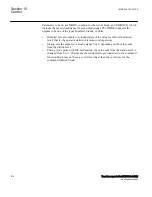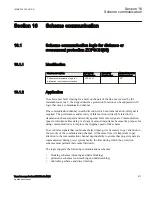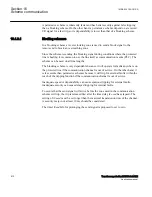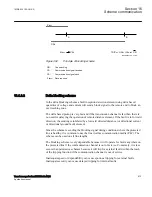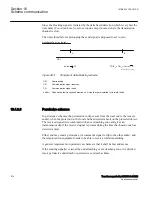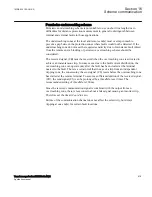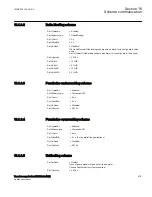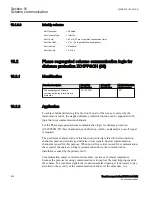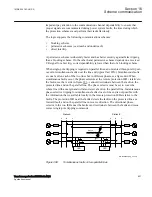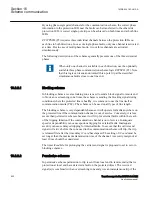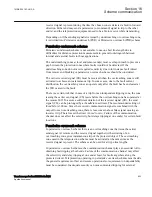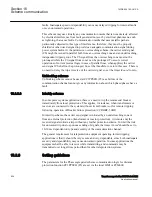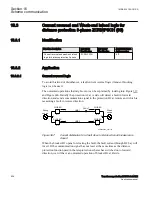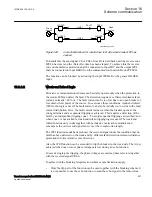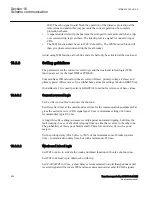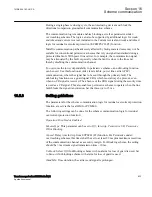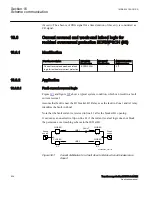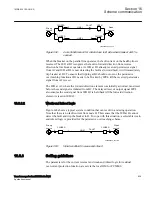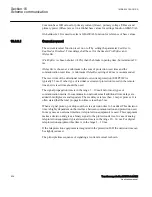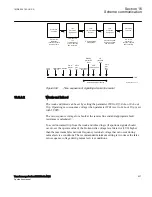
received signal is present during the time the chosen zone is detected a fault in forward
direction. Either end may send a permissive (or command) signal to trip to the other
end(s), and the teleprotection equipment need to be able to receive while transmitting.
Depending on if the sending signal(s) is issued by underreaching or overreaching zone,
it is divided into Permissive underreach (PUR) or Permissive overreach (POR) scheme.
Permissive underreach scheme
SEMOD141790-35 v2
Permissive underreach scheme is not suitable to use on short line length due to
difficulties for distance protection measurement in general to distinguish between
internal and external faults in those applications.
The underreaching zones at local and remote end(s) must overlap in reach to prevent a
gap between the protection zones where faults would not be detected. If the
underreaching zone do not meet required sensitivity due to for instance fault infeed
from remote end blocking or permissive overreach scheme should be considered.
The carrier received signal (CR) must be received when the overreaching zone is still
activated to achieve an instantaneous trip. In some cases, due to the fault current
distribution, the overreaching zone can operate only after the fault has been cleared at
the IED nearest to the fault.
There is a certain risk that in case of a trip from an independent tripping zone, the zone
issuing the carrier send signal (CS) resets before the overreaching zone has operated at
the remote IED. To assure a sufficient duration of the received signal (CR), the send
signal (CS), can be prolonged by a
tSendMin
reset timer. The recommended setting of
tSendMin
is 100 ms. Since the received communication signal is combined with the
output from an overreaching zone, there is less concern about false signal causing an
incorrect trip. Therefore set the timer
tCoord
to zero. Failure of the communication
channel does not affect the selectivity, but delays tripping at one end(s) for certain fault
locations.
Permissive overreach scheme
SEMOD141790-41 v1
In permissive overreach scheme there is an overreaching zone that issue the carrier
send signal. At remote end the received signal together with activating of an
overreaching zone gives instantaneous trip of the protected object. The overreaching
zone used in the teleprotection scheme must be activated at the same time as the
received signal is present. The scheme can be used for all type line lengths.
In permissive overreach schemes, the communication channel plays an essential roll to
obtaining fast tripping at both ends. Failure of the communication channel may affect
the selectivity and delay tripping at one end at least, for faults anywhere along the
protected circuit. Teleprotection operating in permissive overreach scheme must beside
the general requirement of fast and secure operation also requirement on dependability
must be considered. Inadequate security can cause unwanted tripping for external
1MRK 504 163-UUS A
Section 16
Scheme communication
Transformer protection RET670 2.2 ANSI
823
Application manual
Summary of Contents for RELION RET670
Page 1: ...RELION 670 SERIES Transformer protection RET670 Version 2 2 ANSI Application manual ...
Page 2: ......
Page 48: ...42 ...
Page 64: ...58 ...
Page 74: ...68 ...
Page 104: ...98 ...
Page 194: ...188 ...
Page 518: ...512 ...
Page 618: ...612 ...
Page 648: ...642 ...
Page 666: ...660 ...
Page 672: ...666 ...
Page 682: ...676 ...
Page 844: ...838 ...
Page 868: ...862 ...
Page 956: ...950 ...
Page 964: ...958 ...
Page 1004: ...998 ...
Page 1014: ...1008 ...
Page 1015: ...1009 ...


